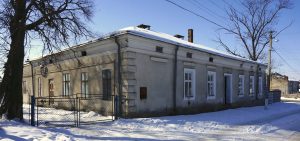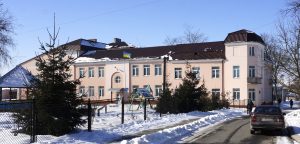(This is a chapter from Jack Glotzer’s memoir, I Survived the German Holocaust Against All Odds. Click here to return to the Table of Contents.)
On Wednesday, July 6, 1941[33] at six o’clock in the evening, the Soviet Army left Rohatyn without firing a shot. The German army marched in their place. The Soviet army left behind heavy ammunition and miscellaneous bullets at the railroad station.

The former municipal bath house in Rohatyn which was across from the Glotzer home on ul. Cerkiewna, 2018.
The non-Jewish population went to the streets to welcome the long-awaited German army. Of course, no Jews were to be seen. The first thing that the Germans did was to take a bath in the municipal bath house (being such “clean” people). Since our house was located not far from the municipal bath house[34] (Łaźnia), we could hear in our house the whole night their drunken shouting and laughter. We were very scared as there was no adult male in our house. The four of us huddled in my mother’s bed clinging to each other and shaking. This is how we spent the first night under the German occupation.
The next day it quieted down, but the fear did not leave us. On Saturday, July 9, 1941[35] (the first black Saturday) the Christian youth began to gather in the marketplace; from there they went to the new parts of the market place where most of the Jews lived. Terrible shouts and cries were heard when the attackers pulled the Jews from their homes. Everybody was panic-stricken. There was no place to escape to, as most of the roads were closed. The Jewish males were forcibly taken by the Germans to the synagogue[36] (Beis Hamidrash). The plan was to set the synagogue on fire (with the Jewish people in it) after taking all their valuables. The plan did not materialize at this time. Many rumors circulated as to the reason for aborting this plan by the Germans. Some people speculated that a refugee from Kraków accidentally met a colleague from a German university who was now a doctor in the German army in Rohatyn. This doctor, upon prodding and begging by his colleague (the refugee from Kraków), intervened with the Germans on behalf of the Jews – so this plan did not materialize. I heard another rumor that a beautiful local woman went to the Germans and sold her body in exchange for the freedom of the imprisoned Jews.
We started to suffer from hunger. The Germans confiscated food for their army. Even the local peasants had to give them their cattle. The Germans caught Jews on the streets and ordered them to clean government buildings. Since we were young, they did not bother us. Nevertheless, they took me and some other Jewish boys to the railroad station to gather all that heavy ammunition (which the Russian army left behind, as I mentioned before). This work was very hard and dangerous in as much as there was some live ammunition. In addition to the fact that we were very hungry, this work was also very tiresome.
By the end of 1941, a ghetto was established in Rohatyn with prominent Jewish citizens of Rohatyn appointed to the Judenrat (Jewish Council).[37] Only the head of the Judenrat (Shlomo Amarant) had direct contact with the Germans. For instance, when the Germans needed workers, they notified the head of the Judenrat to supply the people who were ordered to report immediately to the Germans. The members of the Judenrat believed that they and their families would be spared when the Jews were sent to concentration camps.[38] The ghetto area started at the marketplace and extended to the river Gniła Lipa. Our house was within the ghetto area, so we did not have to move. The entrance to the ghetto was closed with gates, guarded by Jewish policemen. The Jewish policemen had armbands on their left sleeves with the insignia “Jewish Auxiliary Policeman.”[39] The ghetto was crowded; some houses had several families living together in one room (Jews who lived outside of the boundary of the ghetto were brought to live inside of the ghetto area). Jews suffered from hunger in the ghetto starting from the first month. The Germans forbade the peasants to supply food to the Jews in the ghetto. You could see on the streets in the ghetto people swollen from hunger. People with money somehow managed to get some food from daring peasants. In the months of September and October 1941, the Germans brought some heavy equipment and dug ditches for defense purposes, or so we thought (but these ditches were for graves, as we found later). In the early spring and during harvest time 1942, more food was available in the ghetto; the peasants found ways to bring food to the ghetto in exchange for clothing, jewelry, and money.
[33] Jewish survivors of the German occupation of Rohatyn recorded conflicting dates for the entry of the Wehrmacht into town, and several subsequent events. The day/date listed here is not possible, because July 6 was not a Wednesday in 1941 – it was a Sunday. Some other survivors remember July 2 instead (which was a Wednesday). Because “Wednesday” appears in several of the recollections, regardless of the numerical date, probably the actual date was July 2. – Ed. [34] This building stands today at vul. Kotsiubynskoho 5. – Ed. [35] This day/date combination is also mistaken. From other survivor accounts, probably the actual date was July 12, a Saturday. – Ed. [36] Until they were destroyed during the war, a Great Synagogue and several other religious community buildings stood on today’s vul. Valova in one of the oldest parts of Rohatyn. In Hebrew, “Beis Hamidrash” means “House of Learning”. – Ed. [37] The building which housed the Judenrat still stands at vul. Kotsiubynskoho 3. The Nazis aimed to kill the Jews by the hands of the victims themselves. For this, a Jewish council (German Judenrat) was created in most ghettos, and the organization of life in the ghetto was transferred by the Nazis to the prisoners. The head and members of the Judenrats were appointed by the Nazis or elected by the ghetto prisoners. The Judenrats were responsible for carrying out the instructions and commands of the Nazis. They often faced a dilemma: complying with the demands of the occupying power usually meant the death of part of the ghetto population; non-compliance – the threat of one’s own death and/or the killing of a significantly larger number of ghetto prisoners. – Ed. [38] This belief is widespread in the literature on the history of the Holocaust, including, for example, memoirs from the history of the large ghettos in Lviv, Łódź, Lublin, Vilnius, etc. However, the Nazi occupiers, after having exploited the members of the Judenrat, always ultimately killed them or deported them to the death camps, after other Jews. – Ed. [39] The “Jewish ghetto police” (German Jüdische Ghetto-Polizei; the name did not contain the word “auxiliary”) or the “Jewish security service” (Jüdischer Ordnungsdienst), commonly known simply as the “Jewish police”, was created by the Nazi occupation authorities within the Judenrat structure to facilitate the deportation of Jews from the ghetto. Another task of the police was to maintain order on the territory of the ghetto. The fate of Jewish policemen was similar to the fate of members of the Judenrat and their families: the Nazis always killed them, usually last. – Ed.
 Published by the Ukrainian Center for Holocaust Studies, (UCHS), Kyiv. This work is licensed under the Creative Commons Attribution-NonCommercial-NoDerivatives 4.0 International License. To view a copy of this license, visit http://creativecommons.org/licenses/by-nc-nd/4.0/ or send a letter to Creative Commons, PO Box 1866, Mountain View, CA 94042, USA.
Published by the Ukrainian Center for Holocaust Studies, (UCHS), Kyiv. This work is licensed under the Creative Commons Attribution-NonCommercial-NoDerivatives 4.0 International License. To view a copy of this license, visit http://creativecommons.org/licenses/by-nc-nd/4.0/ or send a letter to Creative Commons, PO Box 1866, Mountain View, CA 94042, USA.
<- Back to the previous section

